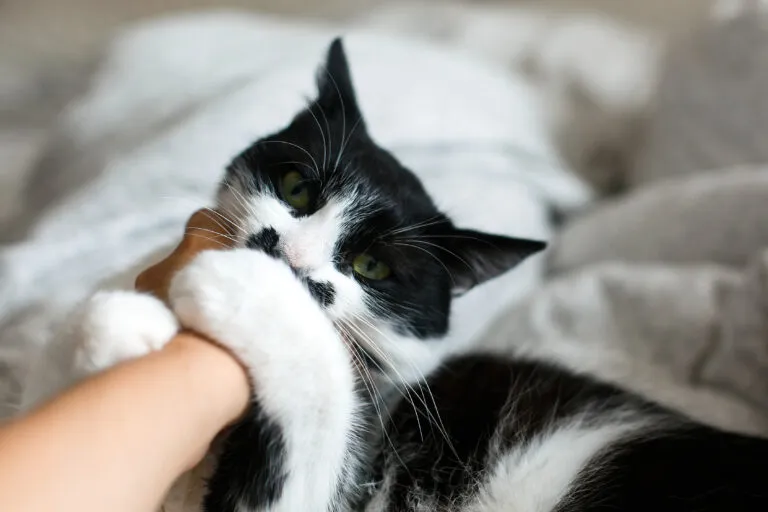Why cat bites can be dangerous
Unlike with cat bites, injuries caused by dog bites are superficial and spread over a larger area. Although tissue damage is usually greater, it is recognised sooner and can therefore be treated earlier.
Cats’ teeth are very long, narrow and pointed compared to those of dogs. At the same time, the canines in particular are slightly curved. A cat’s teeth penetrate deeply into the victim’s tissue when they bite. This can lead to major injuries of important anatomic structures like the tendons, muscles, vessels or nerves.
Cat bites also very often trigger wound infections, since the teeth leave a multitude of germs at the end of the injury. Since the formed passage is usually very deep and narrow, bacteria can multiply undisturbed due to the warmth and humidity. These bacteria include in particular environmental germs, which are normally found in the cat’s mouth. If they enter the victim’s bloodstream, they can reach the entire body and trigger life-threatening sepsis. Dangerous infectious diseases like tetanus (caused by the bacteria Clostridium tetani) or rabies (caused by the rabies virus) can be caused by cat bites. Since bite marks are often overlooked by pet owners in the first few days, the infection risk from cat bites is particularly high.
What symptoms emerge?
Since cat bites very often can’t be recognised straight away due to the victim’s fur or feathers, injured animals are mainly conspicuous due to other accompanying symptoms:
- Pain can lead to increased reluctance to exercise, limping or resting of individual limbs, as well as loud cries of pain with some animals.
- Superficial traces of blood are visible on the fur or feathers.
- Signs of inflammation like swelling, redness and purulence.
- Injuries to the nerves can lead in particular to motor (e.g. paralysis) and sensory consequences (e.g. increased hypersensitivity or insensitivity).
- Bacterial blood poisoning (sepsis) manifests itself through a severely diminished general condition, fever and a decreasing appetite.
- Signs of tetanus are continuing convulsions as well as tonic muscle strain
- Even the smallest cat bites can lead to the death of the victim if unrecognised
Diagnostic measures
If you or a pet were bitten by a cat, it is very important for further planning treatment to take a look at the vaccination card or to determine the existing bacterial flora. If a tetanus vaccination has not been given, the victim’s immune system should be supported as soon as possible with a tetanus immunoglobulin. By taking a smear of the wound, the bacteria can be multiplied in a laboratory on specific culture mediums and then determined by several techniques (e.g. PCR or MALDI-TOF). Additional resistance testing is extremely important for later antibiotic treatment. Along with targeted and effective treatment, this also allows resistant germs to be avoided. Furthermore, it is recommended to examine the blood, nervous system and also deeper anatomical structures with imaging techniques (e.g. ultrasound).
What to do when you get bitten by a cat
If your cat, dog or another pet shows signs of having been attacked by a cat, it’s important to thoroughly examine the whole body for indentation marks. If you only see two bite marks, the presence of further bite marks on the opposite side of the body is very likely.
Nevertheless, a vet (or doctor with human bite victims) should always be consulted for treating cat bites in order to avoid later consequences like bacterial blood contamination. The focus is on the following treatment measures:
- Wound care: emptying and cleaning the bite mark as well as rubbing in an anti-inflammatory ointment. It’s not advisable to stitch the wound, because this means that bacteria and wound secretion can no longer drain off.
- Administration of antibiotics following a resistance test (in the form of ointments and tablets) as well as painkillers
- Operative measures are necessary with severe injuries
What is the prognosis of a cat bite?
Cat bites can be very dangerous due to their high risk of infection. It’s important not to underestimate the situation and to take early measures to avoid wound infections. Bacterial sepsis, tetanus or rabies in particular can prove fatal for the victim. However, the prognosis of a cat bite is much better with effective vaccination and early treatment.
How can bad infections caused by a cat bite be avoided?
Effective vaccination against tetanus and rabies is the most important requirement for a better prognosis with cat bites. Although human rabies in the UK is extremely rare (no human cases of rabies acquired from animals other than bats have been reported since 1902), illegally imported animals can transmit this life-threatening virus by biting. Tetanus vaccinations are part of the NHS childhood vaccination programme and should give longterm protection, however, deeper wounds should still get checked by a GP. Infection with Clostridium tetani from a cat bite still cannot be ruled out. Furthermore, it’s recommended to be careful and to avoid too much or rough handling, especially of unfamiliar cats.
